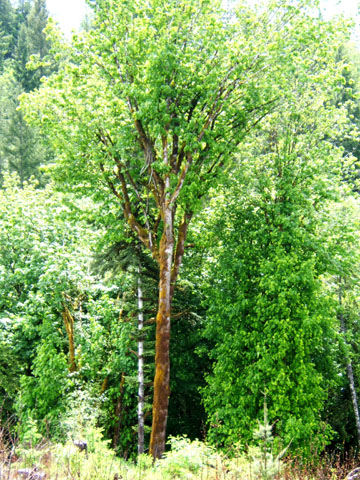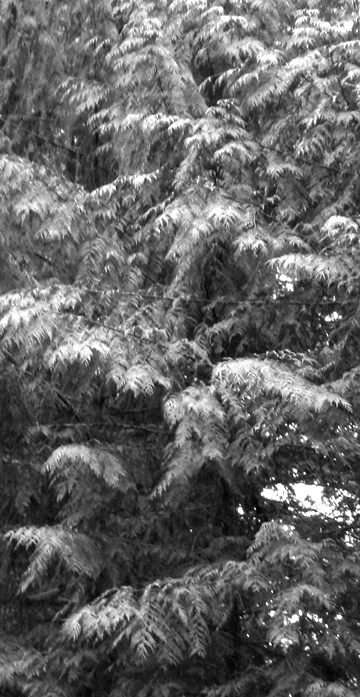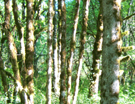Seeding the future: Tree farmers are turning to majestic redwoods for long-term investments
By Diane Dietz, The Register-Guard, November 15, 2009 [here]
Imagine the Coast Range around Noti and Veneta becoming the land of the giant coastal redwood — the tallest tree on earth, the one you can drive your car through.
Some tree farmers are doing more than imagining. They’re planting at least 20,000 coastal redwood trees a year in Lane and Douglas counties, according to the Cottage Grove seedling grower Plum Creek.
They’re driven less by fancy, or the awe the big trees inspire in many people, than by what they see as the best return on their investment in 30 or 40 years, when the trees are harvested.
Coastal redwoods put on volume three or four times as fast as Douglas fir, said Doug Wolf, a Douglas County forester. They can produce a “phenomenal” 5,000 board feet per acre per year. Plant them in blackberries, they shoot up through the fir-killing shade. Cut one down, and the stump will sprout a half dozen new trees. Let a deer or elk eat the tender tops, it can still grow up to 350 feet tall.
“They are quite the rejuvenator,” forester Dick Rohl said. “If you got any mass there, they’ll just take off like the dickens.”
“Like a weed practically,” Wolf added.
But the most compelling fact for those tree farmers planting coastal redwoods this year: Redwood logs are selling for $800 to $1,300 per thousand board feet compared with less than $250 for Douglas fir, according to Random Lengths, a wood products trade publication based in Eugene.
The Lane and Douglas tree farmers planting coastal redwood are betting that time will only widen that price gap.
Chapter 6: The Best Herbaceous Plants
From A Guide to Innovative Tree Farming in the Pacific Northwest by Mike Dubrasich. 2005. Whirlwind Press. For a hard copy of the book ($10 - includes shipping) please contact W.I.S.E. [here].
Best of the Best: Sword Fern (Polystichum munitum)
Runner-Up: Stinging Nettle (Urtica dioica ssp. gracilis)
Herbaceous plants are low-growing and non-woody, about as far from being trees as a plant can get. Most commercial herbaceous plants are more efficiently grown by row-cropping, or as nursery plants, not as tree farm crops. Nevertheless, innovative tree farmers also grow certain commercially valuable herbaceous plants that thrive in shade, and are easy to grow, harvest, and market.
Sword Fern
Sword ferns occur naturally in forests from Alaska to California and east to Montana, although they are more abundant in forests west of the Pacific Crest. Sword ferns survive in full sun (after clearcutting, for instance) but attain their best growth in shade.
Sword ferns have two markets: as live plants or as cut fronds for floral greenery. Nurseries, not tree farms, are the best places to grow live plants for commercial sale. Tree farms are good places to grow sword ferns for their fronds. Fresh-cut fronds are sold to domestic florists and international floral brokers. The market for Pacific Northwest sword fern fronds is truly world-wide.
One caveat tree farmers should be aware of is that the U.S. Forest Service currently encourages sword fern picking on public forests by commercial gatherers. This sad policy is harmful to the forests and harmful to the pickers. The tragic consequences are too numerous to detail here. One consequence, however, is that the ill-conceived Federal harvest depresses sword fern frond prices.
Chapter 5: The Best Shrubs
From A Guide to Innovative Tree Farming in the Pacific Northwest by Mike Dubrasich. 2005. Whirlwind Press. For a hard copy of the book ($10 - includes shipping) please contact W.I.S.E. [here].
Best of the Best: Scouler Willow (Salix scouleriana)
Runners-Up: California Hazelnut (Corylus cornuta var. californica), Oceanspray (Holodiscus discolor)
Honorable Mention: Saskatoon Serviceberry (Amelanchier alnifolia), Lewis Mockorange (Philadelphus lewisii)
Tree farmers plant trees, but shrubs often occur on tree farms naturally. The tree farmer’s choices are to ignore the shrubs, poison them, or make profits from them. Innovative tree farmers choose the third option.
The best tree farm shrubs are easy to grow, easy to market, and provide opportunities to add value. Moreover, the best shrubs provide annual income, and hence greater earning power than a periodic crop. One-year-old shoots (rods) are the products tree farmers harvest from shrubs; coppicing is the method employed. Rods are used in basketry, furniture-making, and a variety of arts and crafts.
Scouler Willow
The best shrub for Pacific Northwest tree farmers to grow is Scouler willow. Taxonomists have identified over 50 species, subspecies, and varieties of willow in our region. Scouler willow is the most common, but many other native willows are excellent rod producers. Scouler willows can grow into small trees, but coppicing keeps them short and manageable.
Chapter 4: The Best Hardwoods
From A Guide to Innovative Tree Farming in the Pacific Northwest by Mike Dubrasich. 2005. Whirlwind Press. For a hard copy of the book ($10 - includes shipping) please contact W.I.S.E. [here].

Best of the Best: Bigleaf Maple (Acer macrophyllum)
Runners-Up: Oregon Ash (Fraxinus latifolia), Bitter Cherry (Prunus emarginata)
Honorable Mention: Red Alder (Alnus rubra)
Innovative tree farmers do not limit themselves to growing conifers only; hardwood tree species are too profitable not to grow. In fact, hardwoods can be much more profitable than conifers.
Hardwoods are more properly termed broad-leaved, flowering trees. Most hardwood trees native to the Pacific Northwest are deciduous; in contrast, most of our conifers are evergreens. The wood from hardwood trees is not necessarily hard, but hardwood wood does have a slightly different cellular structure than conifer wood.
Bigleaf maple
Of the hundreds of native hardwood tree species, bigleaf maple is the best of the best to grow on Pacific Northwest tree farms. It’s very fast-growing, easy to grow, produces multiple high-value products starting at a young age, and provides opportunities to add value.
Chapter 3: The Best Conifers
From A Guide to Innovative Tree Farming in the Pacific Northwest by Mike Dubrasich. 2005. Whirlwind Press. For a hard copy of the book ($10 - includes shipping) please contact W.I.S.E. [here].

Best of the Best: Western Red Cedar (Thuja plicata)
Runners-Up: Alaska Yellow Cedar (Chamaecyparis nootkatensis), Redwood (Sequoia sempervirens)
Honorable Mention: Noble fir (Abies procera)
There are thousands of native plant species in the Pacific Northwest. Hundreds have some commercial potential as tree farm crops. From these I have selected 15 species that I consider to be the best native plants for innovative tree farming. All 15 can economically out-perform Douglas-fir many times over. Innovative tree farmers are growing many more native species than these, but the 15 selected are the best, in my opinion.
I have divided the best species into four groups: conifers, hardwoods, shrubs, and herbaceous plants. Yes, shrubs and herbaceous plants; innovative tree farmers grow multiple species and harvest multiple products from every acre. From each group I have chosen the Best of the Best, the Runners-Up, and the Honorable Mentions. In this chapter I discuss the best conifers. In the next three chapters I discuss the best hardwoods, shrubs, and herbaceous plants.
Conifers are cone-bearing trees with naked seeds (pine nuts do not have shells). Conifers include pines, firs, cedars, cypresses, hemlocks, yews, larches, and Douglas-fir (Pseudotsuga menziesii). Conifers are also called softwoods, although the actual hardness of conifer wood varies greatly between species.
Western Red Cedar
Western red cedar is the best conifer species to grow on individual and family tree farms in the Pacific Northwest. Cedar produces multiple high-value products, starts producing income at a surprisingly young age, is easy to grow, and provides many opportunities to add value.
